Amplitude Techniques
Early defect sizing approaches were based on the amplitude of the returned signal, and correlating it with an equivalent machined reflector such as a notch or side-drilled hole. However, correlation between defect size and amplitude has been poor [2]; this is not a surprise, given the number of variables from the material, equipment and defect itself. The material has potential velocity and microstructural variations, especially steels; the equipment has potential amplitude variations due to the type of pulser, frequency band, cabling, and other inherent electrical parameters. Perhaps the biggest variable is the defect itself. Ultrasonics is highly sensitive to defect orientation; also, transparency, roughness, curvature, location play a role. Conventional ultrasonics is particularly unreliable for vertical defects, though using appropriate inspection angles seems to improve amplitude criteria [3]. The German DGS technique compares defect amplitudes with those from a known reflector [4]; this gives a defect "not smaller than a machined reflector", which is not useful for FFS. All in all, amplitude-based sizing techniques are generally not reliable, certainly by the standards required by FFS. Since the vast majority of defects are still sized by amplitude-based techniques, whether 6 dB drop-off, 10 dB or 20 dB [5], a couple of general comments from field experts are appropriate. First, "any defect smaller than the beam tends to be sized as the beam width". This occurs because small defects tend to be omni-directional emitters, so small defects tend to emit anywhere inside the beam. However, small defects tend not to be structurally important in most cases, so the background data on small defect sizing is limited [6]. Second, "small defects tend to be oversized, and large defects undersized" [7]. The "small defects-oversizing situation" is easily understood from omni-directional emitting and beam spread. However, the "large defects-undersizing" is of more concern. This situation can easily occur if the defect is curved, for example, so a fixed angle transducer beam will roll off the edges, giving lower amplitude and size measurement. Undersizing large defects is potentially a major concern for structural integrity. Diffraction Approaches
In the late 1970's, Silk at Harwell [8] developed a sizing (and detection) technique called Time-Of-Flight Diffraction (TOFD). This technique used low-amplitude diffracted waves from defect tips to size defects, and proved to be significantlymore accurate than amplitude criteria. The basic principle of TOFD is shown in Figure 1.
The diffraction phenomenon is quite general in ultrasonics, and a number of alternative diffraction techniques have been developed with their own advantages and disadvantages. The standard TOFD technique uses a separate pulser and receiver on either side of the weld or component, plus encoded position and computer data recording. TOFD has significant dead zones at the OD and ID, plus interpretation issues. TOFD is also limited on the smallest defect that it can size, typically by beam ringdown (about 3 mm for pipelines). Nonetheless, TOFD sizing results have been impressive. Figure 2 shows a comparison between amplitude-based sizing and TOFD from the UK Defect Detection Trials [9].
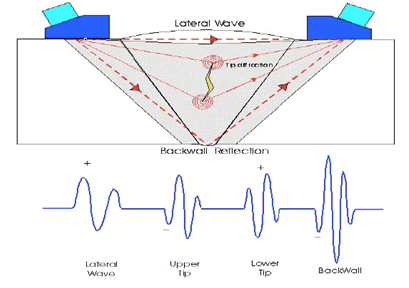
Figure 1: Principles of TOFD
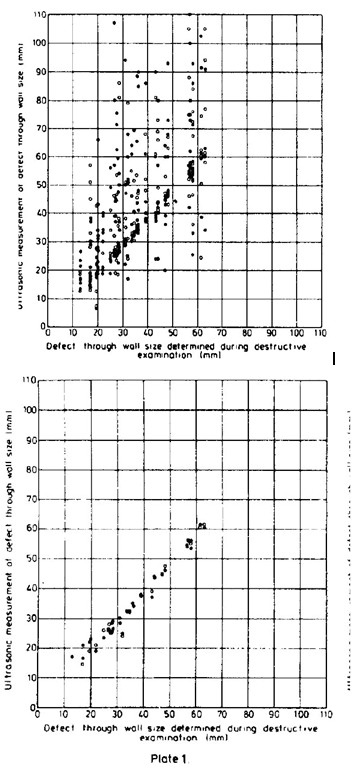
Figure 2: Amplitude vs. diffraction from DDT plate 1 (top: all sizing techniques, bottom: TOFD only).
Various alternative diffraction approaches have been developed, including back diffraction and mixed mode transducers. As well, other techniques based on amplitude and signals have been tried: frequency analysis [10], pattern recognition, HOLOSAFT [11]. In general, none of these latter techniques have become commercial, though back diffraction is frequently used.
Back diffraction uses a single transducer to pulse and detect diffracted signals. This makes the system much simpler, and permits manual operation. However, the physics of back diffraction is weaker than forward diffraction, and identifying the diffracted tip signals can be difficult. Nonetheless, back diffraction offers similar accuracies to TOFD [12], and has advantages for sizing small defects (down to 0.5 mm in pipelines) with smaller dead zones [13]. The basic approach is shown in Figure 3.
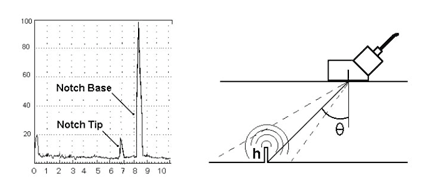 Figure 3: Back diffraction for defect sizing. Figure 3: Back diffraction for defect sizing. Nuclear Sizing Studies
While many industries have been interested in defect sizing capabilities [14], the nuclear industry performed major studies to determine defect detection and sizing capabilities. Two major round robins were PISC II and DDT. The PISC II trial in particular was global, with around fifty teams inspecting four components with about two hundred defects [7]. The size and scope of this study permitted good statistical analysis of the results, sizing accuracy and defect analysis. Not surprisingly, the most difficult defect to find was a smooth crack. However, sizing showed some breakthroughs since a variety of novel techniques were tested. PISC II was the first public trial for TOFD, and the results were encouraging [15]. Overall sizing accuracy for the UKAEA Risley team was a few millimeters on plate hundreds of mm thick (i.e., ~ 1%). There are significant differences between these nuclear studies and current pipeline sizing studies:
• First, the PISC II trial was enormous, permitting substantial parametric studies.
• Second, nuclear pressure vessels are an order of magnitude thicker than pipelines, though it is not possible to increase the ultrasonic frequency in pipelines in ratio due to attenuation in the steel.
• Third, the nuclear industry uses raster TOFD and Synthetic Aperture Focusing (SAFT), which gives somewhat improved accuracies over the petrochemical industry's linear TOFD.
• Fourth, new technology has arrived, including better data handling, processing and display, and phased arrays. While phased arrays do not alter the physics, they do permit multi-angle and optimized inspections.
• Fifth, pipelines routinely use highly focused transducers, which reduces the beam size, improves signal-to-noise ratio, and minimizes spurious geometric reflections.
• Sixth, pipeline defects (d) are typically of the same height as the ultrasound wavelength (λ), which complicates theoretical analysis.
• Seventh, PISC used ground flush surfaces, while pipelines generally have geometric reflectors from the root and cap.
• Last, the quality required (i.e., time and money spent)is generally significantly higher for nuclear than for pipelines. Offshore risers and tendons may be an exception.
Nonetheless, the general conclusions from the nuclear studies apply to pipelines. Pulse-echo detection and sizing have limitations; TOFD is good for sizing (and detection) under most circumstances, but ideally both TOFD and pulse-echo should be used [15]; sizing accuracies of a few millimeters (better with pipelines) are possible. Pipeline Sizing Procedures and Terminology
Unlike the enormously expensive PISC II trials, the pipeline studies tend to be smaller and more fragmented. The details on the methodology tend to be sparse, and the amount of data limited. Unfortunately, many of the pipeline approvals and sizing studies are proprietary, and cannot be published. The list below contains some of the public results. For analysis procedures, pipeline operators often salami-slice the pipes to get an approximate defect size or freeze-break the welds, unlike the meticulous metallography in PISC II. This inherently leads to some errors in sizing and detection; no hard data is available, but metallurgical errors appear to be of the same order as claimed sizing accuracies. Alternative techniques are freeze-breaking and sectioning at the maximum ultrasonic amplitude (which may not be the maximum depth). Pipeline scans are usually performed once (as in the real world), and detailed scans are not used (unlike nuclear). Pipeline sizing is often based solely on zone size as per the ASTM E-1961 code [16], or a modified version of amplitude sizing [17]. Zone sizing is quick and approximate, not detailed like nuclear. Pipeline defect sizing terminology is fuzzy. Normally defect sizing accuracy is quoted as ± Y mm accuracy. The scientific basis for the ± Y mm is not always specified, but could be:
1. The maximum error (maybe two standard deviations (σ) or 95% of the results)
2. The standard deviation σ,
3. ASME RMS value, or
4. A general error band, i.e. an "eyeball range". Some authors specifically quote σ or RMS; in other cases, the procedure seems to be to draw a general error band, often + 1 mm. Few published results support the maximum error since many points lie outside the error band, though texts often imply this is the case. Unfortunately, the number of data points in pipeline studies is generally too limited to produce meaningful statistics. ASME RMS
ASME has a procedure for measuring sizing accuracy [18]. The formula for RMS is almost identical to the standard deviation and sums the measurement errors (squared), divides by the number of points, then takes the square root. The RMS error of the flaw depths should not exceed 3.2 mm. What Do People Really Mean by Sizing Error?
Many defect error sizing plots show an error band of approximately ± 1 mm drawn on. It is the author's opinion that this ± 1 mm "eyeball range" is typically quoted because:
1. It is a convenient number to chose;
2. The 2 mm range roughly corresponds with the focal spot size of a focused pipeline AUT transducer, so sizing more accurately than this is problematic;
3. The 2 mm range also corresponds to typical pipeline zone sizes and GMAW passes;
4. There may be too few data points for meaningful statistics; and
5. Most data points lie within this range, especiallyundersizing. Physics Limitations
As the size of the defect approaches the wavelength (0.4-0.5 mm for 7.5 MHz shear waves), physics becomes an issue for modeling defects in pipelines. (Typical pipeline defects are of the order of one weld pass, i.e., 1-3 mm.) There are two approaches for analysis: analytical and numerical.
Analytical
Analytical approaches, typically using idealized cracks, have used Green's theorem, Kirchoff approximations, Born approximations and the General Theorem of Diffraction [19]. Unfortunately, all these analytical approaches use approximations to make the equations soluble, and these approximations are not valid when the defect size is similar to the wavelength, as for pipelines. Thus analytical theory cannot solve this problem, though obviously ultrasonics is reflected in practice from defects with d~λ. Numerical
Of the various methods of performing numerical assessments, ray tracing will be essentially useless with d~λ. Finite Element Methods and Finite Difference Methods should be successful,though there are still approximations involved. Unfortunately, both FEM and FDM are very time-consuming and expensive [20] and little work has been done in this area. Focal Spot Size
Another major consideration is the minimum focal spot size achievable, especially as the minimum defect size measurable may be limited by focal spot size [6]. The theoretical focal spot size depends on aperture size, frequency (i.e. wavelength)and focal distance. If one assumes a 16 mm aperture, 7.5 MHz and focal distance of 20 mm in water (i.e., a very short focus),the 6 dB half-width approaches 2λ, or 1 mm. This suggests that defects cannot be sized below + 0.5 mm [20]. This correlates with current sizing accuracies from techniques like back diffraction [13], and optimized laboratory results [21].
In contrast, there is a school of thought on pipelines that too small a focal spot is detrimental [4, 17], especially using amplitude approaches. However, these results indicate looser sizing accuracy compared with zone discrimination and other approaches (see below). There are also significant limitations on amplitude techniques, e.g., the defect must be centered in the beam, and must be smaller than the beam. The correlation between signal amplitude and defect size is very poor (see Figure 4 for example).
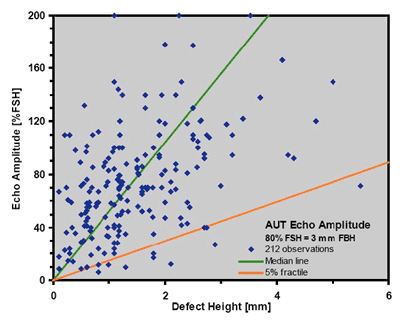
Figure 4: Sample pipeline data comparing amplitude and measured defect sizing [22]
Pipeline Sizing StudiesBattelle PNL Study
In 1981, Battelle performed a nuclear pipeline detection and sizing round robin for the NRC [23] using seven teams. This study investigated several nuclear-type materials including clad ferritic, cast and wrought austenitics; they also investigated real defects, e.g. stress corrosion cracking. While the application, procedures and technology are dated, and the materials different, the results did show that pipeline defect sizing was poor, with major sizing errors. In 1997, Iploca (International Pipeline and Offshore Contractors Association) funded a detection and sizing study at the University of Ghent [4, 24]. While detection was good by both AUT crews, sizing (by one team only) produced a standard deviation of defect sizing to within + 1.5-2 mm for surface breaking defects. This level of sizing accuracy was later confirmed by similar privately sponsored validation projects [24]. The work done by Ghent University also demonstrated that the sizing error of buried defects can be quite significant. Transco Trials: Recently, Advantica analyzed an internal study using GTI funding with seven inspection companies [25]. Approximately ninety typical defects were implanted: porosity, lack of fusion and both copper cracking and transverse defects. While the main thrust of the trial was defect detection (which was good),the defect sizing was not impressive. σ varied from 1.1 to 1.8 mm [26]. Errors of up to 6 mm were found, while TOFD onlyworked for larger, buried flaws.
Shell Results
Kopp et al [27] published an internal study including defect sizing (see Figure 5). This is some of the more comprehensive data available, and shows that there is considerable scatter within the ± 1 mm eyeball range, plus several outlier points. There is also little undersizing, as expected. These results are typical of pipeline data, and it is possible to superimpose several proprietary studies on this plot. The Shell data is a collection from several programs, which complicates analysis. The paper refers to sizing accuracies of ± 0.3 mm, which is impossible to conclude from the published data. This accuracy is predicated on a percentage of the zone size, which is not supported by any published or known proprietary studies. Furthermore, it ignores the problems of focal spot size, amplitude-defect correlation, and d~λ. Eyeballing the data gives a typical range of ± 1 mm accuracy. ![Kopp et al [27] internal study including defect sizing](https://static5.olympus-ims.com/modules/imageresizer/eb5/4c0/c583c84bdd/419x260p210x130.gif) Figure 5: Sizing data from Kopp et al. [27] Figure 5: Sizing data from Kopp et al. [27]
Saipem Study
Cataldo and Legori [28] published a limited data set for DNV approval, which shows a good correlation with defect size (see Figure 6). As with the Shell results, there is little undersizing, though some oversizing. An eyeball range of ± 1 mm would probably not be "out of line". The Saipem results could be easily superimposed on the Shell results above. ![Cataldo and Legori [28] published a limited data set which shows a good correlation with defect size](https://static1.olympus-ims.com/modules/imageresizer/7bc/40d/d995b904d5/451x316p226x158.gif)
One of the more interesting observations is the comparison of conventional multiprobe and phased array AUT systems. When using the same set-up (and nominally the same calibration blocks), the differences are negligible, as predicted by physics. Shell/Shaw [27] used multiprobe; Saipem phased array. Two other comparisons showed no significant detection differences using the same set-ups [25, 29]. Oceaneering OIS
Oceaneering performed a DNV qualification in early 2003, which produced noticeably lower σ than Shell, Saipem or others - σ ~ 0.6 mm. This data set contained mostly sidewall LoF, though the pipe walls were slightly thinner than for Saipem. The actual inspection and sizing procedures were not outlined in the internal document [30]. The results are shown in Figure 7
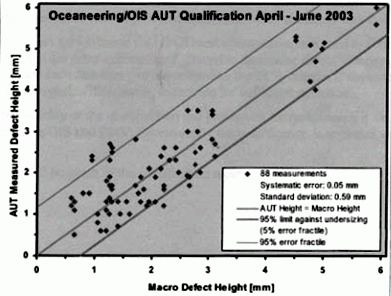
Figure 7 : Comparison of measured and actual defects heights from Oceaneering.
At the time of writing, it is not clear why the Oceaneering results are significantly better than others. Oceaneering did use TOFD extensively to minimize significant oversizing (as seen in Figure 5), but otherwise used standard procedures. Phased arrays offer significant sizing advantages (extra beams, controlled focus), and maybe experience with phased systems has helped as much as improved procedures. EdisonWelding Institute Round Robin Under GTI auspices, EWI performed a round robin with two pipes containing effectively twenty four LoF defects with several inspection companies [21]. The results showed considerable variability between inspection companies, even when using nominally identical procedures. Specifically, in the best case 45% of the defects were sized within + 0.5 mm, and the majority within + 2 mm (see Table 1 below).
As with the Advantica results, only about half the EWI defects could be properly analyzed with TOFD, either because the defects were too small or too close to the surface.
Using multiple techniques and lots of time, EWI measured defects to an accuracy of + 0.6 mm (Category A6-open). The implication is that the more techniques and effort, the better the results. This observation was supported in the PISC II round robin for nuclear pressure vessels [7]. Acronym | Approach Description | Height sizing accuracy, average error "a" in mm and % of detected flaws | | | a<± 0.5 mm | ±0.5>a<±2.0 mm | ±2.0>a <±4.0 mm | A1 | Focused multiprobe, amplitude linearization | 35% | 35% | 30% | A2 | Focused multiprobe, proprietary sizing algorithm | 45% | 45% | 10% | A3 | Non-focused multiprobe, zone and ampl. Rules | 30% | 45% | 25% | A4 | Focused PA, 48 el., ampl. linearization | 40% | 20% | 40% | A5 | Focused PA, 64 el., ampl. linearization | 15% | 35% | 50% | A6 | Focused PA, 64 el., sectorial scanning | 25% | 25% | 50% | A6
open | Focused PA, 32 el., raster and sectorial | 75% | 25% | n/a |
Table 1: EWI table 2, "Achieved Sizing Accuracy" [21]
Det Norske Veritas
Studies by DNV on defect sizing using one amplitude-based and one TOFD-based data set showed an atypically low σ [22]. Undersizing was minimal, and the systematic error was small in both cases, ~ 0.1 mm, as with other studies. The standard deviation was ±0.41 for one data set and ± 0.62 for the other set. These results showed a significantly lower error than most, approximately one third of some other values, though comparable with the Oceaneering results. However, Oceaneering only supplied 88 points, while DNV uses 204. Figure 8 is an agglomeration of a number of studies, and no details are available, so conclusions on optimum techniques and procedures are difficult [31]. This difference may be due to analysis, process or statistical treatment. Another low σ obtained from laboratory results from EWI above is due to multiple techniques and considerable time and effort [21]. Improved results can be expected from such a detailed
inspection [6]. Perhaps the most impressive results come from the Oceaneering data using standard equipment [30].
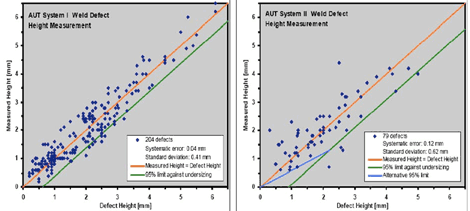
Figure 8: DNV sizing results [22]
R/D Tech Data
R/D Tech has some early proprietary sizing data that could be overlaid on Figures 5-8 without significant distortion. The features are similar: some scatter (within an eyeball range of ± 1 mm), limited undersizing and some significant oversizing,low mean sizing error. In practice, an RMS analysis of the sizing accuracy using the ASME approach gave a value of over ± 1.1 to 1.7 mm, depending on the actual data set used (ASTM zones, modified zones, TOFD and combinations). The combined techniques gave better results (smaller σ) than simple zones. This data set also showed that TOFD for pipelines was limited, and typically only half the defect sizes could be directly measured by standard TOFD. |
In practice, with the exception of the Oceaneering and EWI results, the available data seems to be fairly self-consistent, with the RMS and σ typically over 1 mm. Much of the data can be overlaid without serious distortion, suggesting that the key issue is technology limits, not operator experience or equipment. Mean error is typically well below 1 mm, with limited undersizing. At this point in time, most evidence suggests that sizing accuracies greater than σ ± 1 mm are not realistic. The proprietary R/D Tech data set suggests that an "eyeball range" of ± 1 mm is really an RMS or standard deviation of <± 1 mm. However, the data is not strictlycomparable since test conditions vary, AUT procedures are not identical, sectioning varies, etc. Generally, mean sizing error is small, typically close to zero mm. Diffraction techniques offer a lot more potential than amplitude techniques, though TOFD in particular has limitations with the smaller defects (and the near surface defects). Relying on amplitude techniques alone will typicallylimit sizing accuracy to the focal spot diameter (~2 mm, or the eyeball range of ± 1 mm as found in recent studies), with frequent outliers. Apportioning amplitudes does not improve σ values much. Undersizing is generally not a major issue. In principle, TOFD should minimize the number of gross overcalls. Current requests for defect sizing to ± 0.3 mm accuracy in plant (again, terminology undefined) seem unrealistic from these published results. There is no evidence that unpublished (or proprietary) results show any significant improvement. On nuclear materials using much shorter λ and perfect geometry, repeatable accuracies of ± 0.1 mm have been achieved [32]. However, such ultrasonic frequencies are impossible in ferritic steels, which are more microstructurally-limited. Though some work has been done on the limits of ultrasonics in steels [33], more should be done specifically on pipeline materials and AUT conditions. From an FFS perspective, the best solution with current technology is to add ± 1 mm to ±1.5 mm to all sizing estimates for conservatism; this should cover any undersizing. For larger defects, the best solution is to use more than one technique to avoid the gross oversizing (5 mm or more) that can occur [22]; typically use zone discrimination, TOFD, back diffraction, and multiple angles [6] if time permits (especiallyfor risers and tendons).
Unfortunately, in-service inspections are probably significantly worse than laboratory round-robins. The good news is that more recent results (Oceaneering and EWI) are notably better than earlier results (Shell and Advantica). Fortunately, work is underway on alternative and improved sizing techniques. R/D Tech is working on a number of fruitful areas:
1. Back Diffraction [13]: This technique offers potential for measuring defects down to ± 0.5 mm, though it has not been proved in trials. The main problems are correct signal identification and ring-time resolution.
2. TOFD Signal Processing [34]: This technique deconvolves the TOFD signals to permit smaller defects to be sized. Initial results are encouraging, but like all DSP techniques, misfiring is possible.
3. Improved Focusing [35]: An increased number of elements and matrix array should decrease the focal spot size, and produce improved sizing accuracy.
There are doubtless other developments going on elsewhere in the world. |
[1] Ginzel E.A., 2000, "Mechanized Ultrasonic Inspections of Pipeline Girth Welds - A Brief History", NDT.net, 2000, Vol 5. No. 03,
http://www.ndt.net/article/v05n03/eginzel/eginzel.htm
[2] Gruber G.J., G.J. Hendrix and W.R. Schick, 1984, "Characterization of Flaws in Piping Welds using Satellite Pulses", Materials Evaluation, Vol. 42, p. 426.
[3] Bray A.V. and R.K. Stanley, 1995, "An Analysis of UT Amplitude Comparison Flaw Sizing and Dissection Results in Steel Pipe", NDE-Vol 13, NDE for the Energy Industry, ASME, p. 85.
[4] Dijkstra F.H., J. v.d. Ent and T.J. Bouma, 2000, "Defect Sizing and ECA: State of the Art in AUT", Pipeline Technology Conference, Brugges, 21-24 May.
[5] Ismail M.P. and A.B. Muhammad,1998, "Defect sizing by ultrasonic ANDSCAN", Insight vol. 40, no. 11, p. 769.
[6] Murphy R.V., 1987, "Ultrasonic Defect-Sizing using Decibel Drop Methods, Vol 1: Text", Atomic Energy Control Board Project No. 85.1.9, Canada.
[7] PISC, 1997, Welding Research Council Bulletin 420, Abstracted by S.H. Bush, Ch. 7.
[8] Silk M.G., 1979, "Defect Sizing using Ultrasonic Diffraction", British Journal of NDT,, p. 12.
[9] Charlesworth J.P. and J.A.G. Temple, 1989, "Ultrasonic Time of Flight Diffraction", Research Studies Press.
[10] Adler L., K.V. Cook, H.L. Whaley and R.W. McClung, 1977, "Flaw Size Measurement in a Weld Sample by Ultrasonic Frequency Analysis", Materials Evaluation, p. 44.
[11] Schmitz V., W. Müller and G. Schäfer, 1984, "Flaw Sizing and Flaw Characterization with HOLOSAFT", Materials Evaluation, Vol. 42, p. 439.
[12] Baby S., T. Balasubramanian and R.J. Pardikar, 2002, "Estimation of the height of surface-breaking cracks using ultrasonic methods", Insight vol. 44 no. 11, p. 679.
[13] Jacques F., F. Moreau and E. Ginzel, 2003, "Ultrasonic Backscatter Sizing Using Phased Array -Developments in Tip Diffraction Flaw Sizing", submitted to Insight.
[14] Zippel W., J. Pincheira and G.A. Washer, 2000, "Crack Measurement in Steel Plates using TOFD Method", Journal of Performance of Constructed Facilities, p. 75.
[15] Highmore P.J., A. Rogerson and L.N.J. Poulter, 1988, "The Ultrasonic Inspection of PISC II Plate 2 by the Risley Nuclear Laboratories", British Journal of NDT, p. 9.
[16] ASTM 1998, E 1961-98, "Standard Practice for Mechanized Ultrasonic Examination of Girth Welds Using Zonal Discrimination with Focused Search Units", American Society for Testing and Materials.
[17] Gross B., T.S. Connelly, H. van Dijk and A. Gilroy-Scott, 2001, "Flaw sizing using mechanized ultrasonic inspection on pipeline girth welds", NDT.net, Vol. 6, No. 7.
[18] ASME, 2001, "Performance Demonstration for Ultrasonic Examination Systems", Appendix VIII, p. 331, American Society of Mechanical Engineers.
[19] Kraut E.A., 1976, "Review of Theories of Scattering of Elastic Waves by Cracks", IEEE Transactions on Sonics and Ultrasonics, Vol. SU-23, No. 3, p. 162.
[20] Mair H.D., 2003, private communication, 2003.
[21] Lozev M., 2002, "Validation of Current Approaches for Girth Weld Defect Sizing Accuracy by Pulse-Echo, Time-Of-Flight Diffraction and Phased Array Mechanized Ultrasonic Testing Methods", EWI Project No. 45066CAP.
[22] Förli O., 2002, "Qualification of AUT for Offshore Pipelaying and the Role of NDT", 3rd European-American Conference on NDT Reliability and Demining", Berlin, 10-13 September.
[23] Heasler P.G. and S.R. Doctor, 1976, "Piping Inspection Round Robin", NUREG/CR-5068, PNNL-10475.
[24] Denys R., T. Lefevre, C. de Jaeger, S. Claessens, 2000, Study on "Weld Defect Acceptance Criteria", Final report for a group of sponsors, Laboratorium Soete, Gent, Belgium, May 2000.
[25] Morgan L., 2002, "The Performance of Automated Ultrasonic Testing (AUT) of Mechanised Pipeline Girth Welds", 8th ECNDT, Barcelona. Also, www.ndt.net/article/ecndt02/morgan/morgan.htm
[26] Morgan L., P. Nolan, A. Kirkham and P. Wilkinson, 2003, "The use of automated ultrasonic testing (AUT) in pipeline testing", Insight November.
[27] Kopp F., G. Perkins, G. Prentice, D. Stevens, 2003, "Production and Inspection Issues for Steel Catenary Risers", Offshore Technology Conference, Houston, 5-8 May 2003.
[28] Cataldo G. and R. Legori, 2003, "Advanced Ultrasonic Techniques in Pipeline Girth Welds Examination", ASME PVP-Vol. 456, Paper number PVP2003-1852, p. 49.
[29] Sjerve E., D.C. Stewart and G.F. Bryant, "Comparison of Multi-Probe and Phased Array Girth Weld Inspection Systems", IPC 2000, ASME 2000 International Pipeline Conference, Calgary, Alberta, October 1-5, 2000, page 827830.
[30] Oceaneering International, 2003, private communication.
[31] Förli O., 2003, private communication.
[32] Lindenschmidt K. and M. Moles, 1991, "Crack Depth Measurements in Thin-Walled Tubing by Time-Of-Flight", Review of Progress in Quantitative NonDestructive Evaluation, Vol. 11, p. 2093.
[33] Mudge P.J., 1981, "Size Measurement and Characterization of Weld Defects by Ultrasonic Testing", Part 3: The effect of metallurgical features in ferritic steels", The Welding Institute Reference 3527/11/81.
[34] Honarvar F., T. Dusatko, Y. Fan, F. Farzbod, M. Moles and A.N. Sinclair, 2003, "A novel signal processing technique for enhancement of time-of-flight diffraction (TOFD) signals", ICPIIT VIII, Houston, June 18-21, 2003.
[35] GTI, 2003, Gas Technology Institute Project "Control of Horizontal Beam Width with Phased Array Transducers RPTG-0334", by R/D Tech.
|

